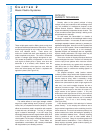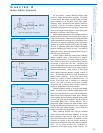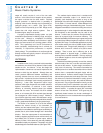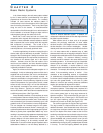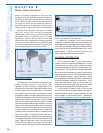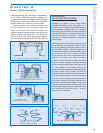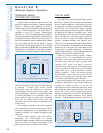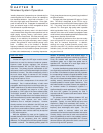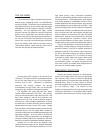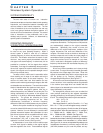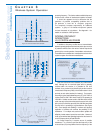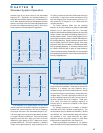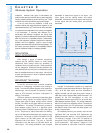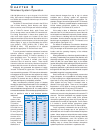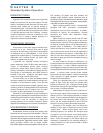
THE UHF BAND
The low-band UHF range of frequencies may be con-
sidered as two overlapping bands: low (450-536 MHz)
and high (470-806). The primary users of these bands are
business services such as land mobile radio and pagers
(450-536 MHz) and UHF television channels 14-69 (470-
806 MHz). As in the high-band VHF region, unused
television channels are allotted for wireless microphone
system use by broadcasters and video/film producers.
There are many primary users (business and television) in
the low part of the band, but interference from primary
users is rare in the high (non-business) part of the band,
due to the relatively small number and shorter range of
UHF television stations. Other secondary users and RF
noise are also less likely at these frequencies.
Like high-band VHF, licensing is still required in this
UHF band. The required minimum quarter-wave antenna
size for UHF radio waves is 9-16 cm (only one-quarter to
one-third that for VHF). Equipment is moderately
expensive and diversity systems are strongly
recommended, but high quality audio can be achieved
along with a large number of simultaneous systems.
The high-band UHF range (900 MHz and above)
includes studio-to-transmitter links (STL), other primary
users, and a host of secondary users. (See Figure 3-3.) This
band offers additional channels and potentially less
interference from RF noise, as well as antenna lengths of
less than 9 cm. Other operating characteristics are similar
to low-band UHF. However, secondary users are allowed to
operate without licensing in much of this range. Though
there have been some wireless microphone products in this
unlicensed range, it has now largely been occupied by
consumer products such as cordless telephones and home
audio/video repeaters. As in the cases of 49 MHz and
169-172 MHz ("traveling" frequencies), the proliferation of
consumer wireless products has rendered the 900 MHz
band all but unusable for professional wireless operations.
Recently, the 2.4 GHz band has attracted some
interest for wireless microphone use. Potential advantages
of this band are: very short antennas (less than 4 cm.), no
high power primary users, international availability
(almost), no bandwidth/modulation scheme limits, and no
license requirement. Unfortunately, these same features
have already attracted a considerable number of users:
cordless telephones and short-to-medium range wireless
network applications such as "Bluetooth" and "Wi-Fi." Add
to this the existing base of 2.4 GHz users that includes the
ISM (Industrial, Scientific, and Medical) band as well as the
lowly microwave oven and it would appear that this band
may be subject to the same fate as its other unlicensed
predecessors. However, many of the devices in this band
use a "spread-spectrum" modulation scheme, which
reduces mutual interference to some extent. It remains to
be seen how they may coexist with wireless audio systems.
Finally, it should be kept in mind that the allocation of
these bands is always subject to change as demand for
spectrum increases. In the US, for example, proposals to
designate unused VHF TV channels in major urban areas
for use by land-mobile services are being considered.
Some unused high-band UHF TV channels are being
re-allocated for public safety radio systems while others
will be auctioned off to commercial wireless
communication services. As always, manufacturers and
users must continue to evaluate these developments for
their impact on wireless system operation.
FREQUENCY SELECTION
Selecting the operating frequency of a wireless audio
system is a two-step process: first, choose an appropriate
radio frequency band; second, choose the appropriate
operating frequency (or frequencies) within that band. As
indicated above, there is a finite number of wireless
microphone systems that may be used simultaneously in
any one frequency range. The reasons for this
limitation are several and they fall under the general topic
of frequency coordination or "compatibility." We will define
these factors and examine each in terms of origin, effects,



